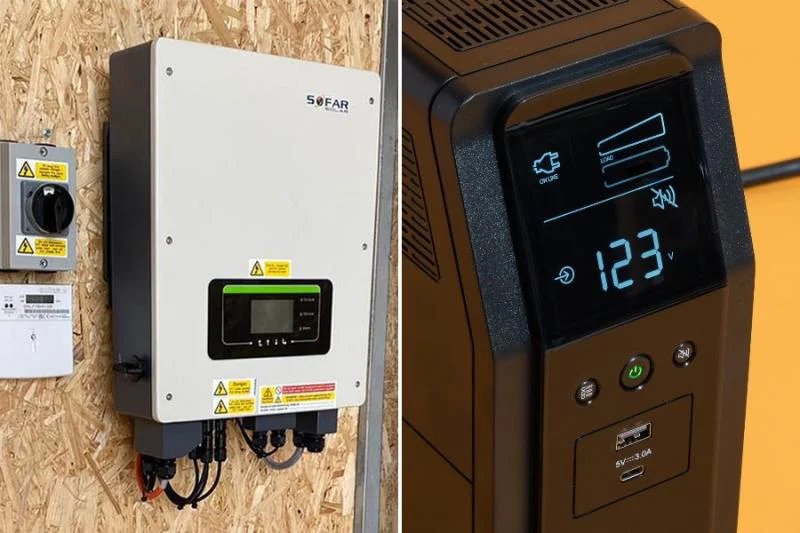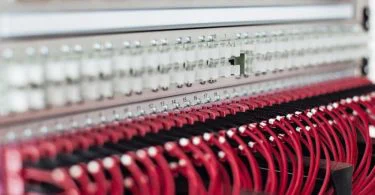Both an inverter and an Uninterruptible Power Supply (UPS) are used to back up power, but they work and respond in different ways. During a power outage, an inverter converts the direct current (DC) from batteries into alternating current (AC), which can be used to power electronics. But it takes a few milliseconds to switch from the primary power source to the backup, so there is a temporary loss of power. On the other hand, an uninterruptible power supply (UPS) keeps power going by charging its battery while also giving power to connected devices. In the event of a power outage, the UPS switches immediately to battery mode, which keeps the power going without delay.
What is Inverter?
An inverter is an electrical device that changes direct current (DC) from a battery or other DC power source into alternating current (AC), used to run electrical appliances and equipment. Inverters are often used in power backup systems, solar installations, and portable power generators. They are an essential link between DC power sources and AC-powered devices.
In backup power systems, inverters are very important when the power goes out. They can tell when the energy from the mains goes out and switch to the battery supply. The stored DC power is turned into the AC power that electrical devices need. But this change usually takes a few milliseconds, so the power goes out for a short time.
Different kinds of inverters, such as pure sine wave, modified sine wave, and square wave, differ in how good the AC waveform they make is. Pure sine wave inverters have the cleanest and most stable output, similar to utility companies’ power. On the other hand, modified sine wave and square wave inverters make less-than-ideal waveforms, which may affect how some sensitive electrical devices work.
Inverters are used in renewable energy systems, like solar panels, that make DC power. They are also used as a backup power source. Inverters convert this DC power into AC power so that it can be used in homes or sent back into the power grid. In short, inverters are essential devices that transform DC power into AC power. This allows electrical appliances and equipment to work in various situations, such as power backup systems and installations of renewable energy.
What is UPS?
An Uninterruptible Power Supply (UPS) is an electrical device that is made to keep connected equipment running even when the power goes out, the voltage changes, or there are other problems with the power. It ensures that essential systems like computers, servers, and telecommunications equipment run smoothly, preventing data loss and damage to equipment.
A UPS’s main parts are a battery, an inverter, and a rectifier. During regular operation, the rectifier turns AC power into DC power, which charges the battery and sends power to the inverter. The inverter then turns DC power back into AC power for plugged devices. This process keeps the equipment from being affected by power surges and drops.
If the power goes out, the UPS immediately switches to battery power and keeps the AC power flowing without noticeable delay. This is a big reason why UPS systems are better than traditional inverters, which have a short time to switch over.
Different kinds of UPS systems exist, like standby, line-interactive, and online (double-conversion). Standby and line-interactive UPSs offer essential power protection, but online UPSs provide the highest power conditioning, isolation, and continuous power availability.
In short, an uninterruptible power supply (UPS) is essential for protecting critical equipment from power outages. It does this by supplying power without interruption, regulating voltage, and protecting against power disturbances. Its main advantage over traditional inverters is that it smoothly switches to battery power when the power goes out. This keeps things running and reduces the chance of data loss or equipment damage.
Difference Between Inverter and UPS
UPS (Uninterruptible Power Supply) and inverters differ fundamentally in how they handle power outages and how quickly they restore electricity. The battery in an uninterruptible power supply (UPS) is charged while the device is powered. In a blackout, it immediately enters battery mode to continue functioning normally. However, during power outages, an inverter will convert DC power from a battery to AC power for electrical devices; however, this will cause a brief disruption in service while the inverter switches from the primary source to the backup.
Functionality
Whereas an inverter converts DC from a battery or other DC power source into AC to power electrical equipment during a power outage, an uninterrupted power supply (UPS) charges its battery. It supplies electricity to connected devices in a single step.
Response Time
In a blackout, a UPS will immediately transition to battery mode. In contrast, an inverter will take a few milliseconds to convert from the main supply to the backup, resulting in a brief interruption of power.
Power Conditioning
Compared to an inverter, an uninterruptible power supply (UPS) provides power conditioning and surge protection, guaranteeing a clean and reliable electricity supply to the connected devices.
Output Waveform
In contrast to a UPS, which produces a sine wave output similar to that provided by utility companies, an inverter can provide a pure sine wave, a modified sine wave, or even a square wave.
Backup Time
The amount of time an inverter can offer backup power depends on the battery’s capacity and the power consumption of the connected devices. In contrast, a UPS’s backup time can range from a few minutes to several hours.
Cost
The added features and capabilities of a UPS cause it to be more expensive than an inverter.
Installation
While an inverter is usually placed near the battery or other power source it is converting, an uninterruptible power supply (UPS) is situated between the primary power supply and the equipment it safeguards.
Battery technology
While sealed lead-acid or lithium-ion batteries are usual for uninterruptible power supplies (UPSs), an inverter’s battery options are far more flexible.
Use Cases
Powering mission-critical devices with a UPS is the best option, while an inverter can be used as a backup in the event of a blackout or to generate power on the go.
Maintenance
To keep functioning at peak efficiency, a UPS needs frequent maintenance, such as battery replacement, while an inverter requires occasional attention.







